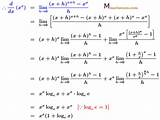What Is The Derivative Of X To The X
News Leon
Mar 26, 2025 · 5 min read

Table of Contents
What is the Derivative of x to the x? A Comprehensive Guide
The derivative of x<sup>x</sup> isn't immediately obvious. Unlike simple power functions or exponential functions, this involves a variable in both the base and the exponent. This necessitates a clever application of calculus techniques, specifically logarithmic differentiation. Let's delve into the process, exploring its nuances and applications along the way.
Understanding the Challenge: Why Not the Power Rule?
Before tackling the solution, it's crucial to understand why the standard power rule, d/dx(x<sup>n</sup>) = nx<sup>n-1</sup>, doesn't work here. The power rule applies when the exponent is a constant. In x<sup>x</sup>, the exponent is itself a variable, making the power rule inapplicable. Similarly, the exponential rule, d/dx(a<sup>x</sup>) = a<sup>x</sup>ln(a), fails because the base is also a variable.
The Power of Logarithmic Differentiation
Logarithmic differentiation provides an elegant solution. This technique simplifies the differentiation of complex functions by taking the natural logarithm (ln) of both sides of an equation before differentiating. Let's break down the process step-by-step:
1. Let y = x<sup>x</sup>
This is our starting point. We're aiming to find dy/dx.
2. Take the Natural Logarithm of Both Sides:
ln(y) = ln(x<sup>x</sup>)
Using the logarithm power rule (ln(a<sup>b</sup>) = b ln(a)), we simplify this to:
ln(y) = x ln(x)
3. Implicit Differentiation:
Now, we differentiate both sides with respect to x, remembering that y is a function of x and using the chain rule and product rule where needed:
d/dx[ln(y)] = d/dx[x ln(x)]
This gives us:
(1/y) * (dy/dx) = ln(x) + x * (1/x)
Simplifying further:
(1/y) * (dy/dx) = ln(x) + 1
4. Solve for dy/dx:
Multiplying both sides by y, we isolate dy/dx:
dy/dx = y * (ln(x) + 1)
5. Substitute Back for y:
Since y = x<sup>x</sup>, we substitute this back into the equation:
dy/dx = x<sup>x</sup> (ln(x) + 1)
This is the derivative of x<sup>x</sup>.
Interpreting the Result: What Does it Mean?
The derivative, x<sup>x</sup>(ln(x) + 1), tells us the instantaneous rate of change of the function x<sup>x</sup> at any given point x. It's a combination of the original function and a term involving the natural logarithm of x. The presence of the ln(x) term reflects the complexity introduced by having a variable in both the base and the exponent. Let's analyze the components:
-
x<sup>x</sup>: This is the original function itself. Its presence indicates that the rate of change is directly proportional to the function's value.
-
(ln(x) + 1): This term modifies the rate of change. As x increases, ln(x) also increases, amplifying the rate of change. The "+1" adds a constant contribution to the rate of change.
Exploring the Behavior of the Derivative: Positive and Negative Values
It's insightful to consider when the derivative is positive and negative. The derivative x<sup>x</sup>(ln(x) + 1) is positive when:
-
x > 1/e: This is because ln(x) > -1 when x > 1/e. For x values greater than approximately 0.368, the derivative is positive, meaning the function x<sup>x</sup> is increasing.
-
0 < x < 1/e: In this interval, ln(x) < -1, making (ln(x) + 1) negative. However, since x<sup>x</sup> is always positive for positive x (excluding 0), the derivative will be negative, indicating a decreasing function.
The derivative is zero only at x = 1/e, which represents a local minimum. For x ≤ 0, the function x<sup>x</sup> is not defined in the real number system (though it can be extended to complex numbers using complex logarithms, which is beyond the scope of this basic explanation).
Applications and Further Exploration
The derivative of x<sup>x</sup>, while seemingly a theoretical exercise, has applications in various fields:
-
Calculus and Analysis: It serves as a good example of applying advanced differentiation techniques and helps illustrate the power and versatility of logarithmic differentiation.
-
Numerical Analysis: The derivative is useful in optimization problems, finding roots of equations, and approximating function values.
-
Modeling and Simulation: The function x<sup>x</sup> and its derivative can appear in models that describe growth, decay, or other processes where both the base and exponent are variable.
Further exploration could include:
-
Higher-order derivatives: Finding the second, third, and higher-order derivatives of x<sup>x</sup>.
-
Generalization: Examining the derivative of functions of the form f(x)<sup>g(x)</sup> using logarithmic differentiation.
-
Complex Analysis: Investigating the behavior of x<sup>x</sup> and its derivative in the complex plane.
-
Graphical Representation: Creating graphs of x<sup>x</sup> and its derivative to visualize their behavior and relationships.
Conclusion: Mastering the Derivative of x to the x
Understanding the derivative of x<sup>x</sup> goes beyond simply finding the answer; it's about grasping the underlying principles of logarithmic differentiation and appreciating its application in more complex scenarios. The seemingly simple function x<sup>x</sup> presents a rich opportunity to refine calculus skills and explore the intricate beauty of mathematical functions. By mastering this derivative, you'll be well-equipped to tackle similar challenges and further deepen your understanding of differential calculus. The derivation, x<sup>x</sup>(ln(x) + 1), not only provides the answer but also reveals insights into the function's behavior and its applications across different domains. It is a testament to the elegance and power of calculus in unraveling the mysteries of seemingly simple, yet surprisingly complex, mathematical expressions.
Latest Posts
Latest Posts
-
How Much Seconds Are In A Week
Mar 29, 2025
-
Is Boron A Gas Solid Or Liquid
Mar 29, 2025
-
How Do You Factor 2x 2 7x 3
Mar 29, 2025
-
What Is 0 025 As A Percentage
Mar 29, 2025
-
Integrated Rate Law For Zero Order Reaction
Mar 29, 2025
Related Post
Thank you for visiting our website which covers about What Is The Derivative Of X To The X . We hope the information provided has been useful to you. Feel free to contact us if you have any questions or need further assistance. See you next time and don't miss to bookmark.
